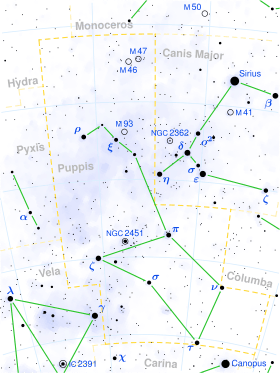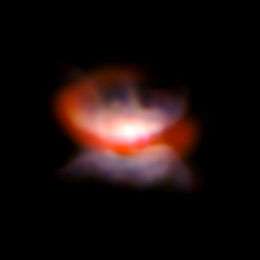L2 Puppis
L2 Puppis (also known as HD 56096) is a giant star in the constellation of Puppis and is located between the bright stars Canopus and Sirius. It is a semi-regular pulsating star.
 | |
| Observation data Epoch J2000 Equinox J2000 | |
|---|---|
| Constellation | Puppis |
| Right ascension | 07h 13m 32.31810s[1] |
| Declination | −44° 38′ 23.0630″[1] |
| Apparent magnitude (V) | 5.10[2] 2.6 – 6 (GCVS)[3] 6 – 8 (1995 – )[4] |
| Characteristics | |
| Spectral type | M5IIIe[3] |
| U−B color index | +1.24[2] |
| B−V color index | +1.56[2] |
| Variable type | SRb[3] |
| Astrometry | |
| Radial velocity (Rv) | 33.0[5] km/s |
| Proper motion (μ) | RA: 106.31[1] mas/yr Dec.: 324.99[1] mas/yr |
| Parallax (π) | 15.61 ± 0.99[1] mas |
| Distance | 210 ± 10 ly (64 ± 4 pc) |
| Details | |
| Mass | 0.659±0.043[5] M☉ |
| Radius | 123±14[5] R☉ |
| Luminosity | 2000±17[5] L☉ |
| Surface gravity (log g) | 0.078±0.027[5] cgs |
| Temperature | 3500±250[5] K |
| Age | 10[5] Gyr |
| Other designations | |
| Database references | |
| SIMBAD | data |
The designation L2 has a tangled history. This star and another were both labelled with "L' by Nicolas Louis de Lacaille when he created the constellation Puppis within Argo Navis.[6] The two stars were labelled as "1.L" and "2.L" by Johann Elert Bode in the catalogue accompanying his Uranometria atlas.[7] Later authors used L1 and L2, usually with numeric subscripts (i.e. L1 and L2),[8] but occasionally as superscripts.[9] The subscripted designation is now universally used where typography allows for subscripts.[5][10]
L2 Puppis was discovered to be variable by Benjamin Apthorp Gould in 1872,[11] and was listed in Uranometria Argentina as 73 G. Puppis with magnitude 5.10v. It has never been given a formal variable star designation, unlike L1 Puppis which is OU Puppis.[12]
L2 Puppis varies in apparent magnitude by about 2 magnitudes with a period of 140 days. The average brightness also varies slowly over several years so that the total range is given as magnitude 2.6 – 6.0. Since 1995 the average brightness has dropped so that the 140 day variations are now between about magnitude 6 and 8.[13][4] The variation in light may be caused by a combination of radial pulsations in the star's atmosphere and by dimming from circumstellar dust.[14]
L2 Puppis is most likely an asymptotic giant branch star that has passed through the main sequence and is evolving to become a white dwarf. It is shedding mass at the rate of about 5×10−7 M☉ per year, forming a circumstellar dust disk and bipolar plumes of gas that are thought to be the start of a "butterfly"-type planetary nebula.[5]
It has been calculated that the mass of L2 Puppis is currently about 0.66 M☉ and its original mass was close to one M☉ about 10 billion years ago.[5] Other calculations give higher masses, for example 2+1
−0.5 M☉, and younger ages such as 1.5 billion years.[10]
A candidate exoplanet has been found orbiting L2 Puppis every 4.69 years at a distance of 2.43 AU. The mass is highly uncertain, at 12 ± 16 MJ, and it might just be a dense clump of gas and dust.[5]
L2 Puppis has a visual 12th magnitude companion about a minute of arc away.[15]
References
- Van Leeuwen, F. (2007). "Validation of the new Hipparcos reduction". Astronomy and Astrophysics. 474 (2): 653. arXiv:0708.1752. Bibcode:2007A&A...474..653V. doi:10.1051/0004-6361:20078357.
- Ducati, J. R. (2002). "VizieR Online Data Catalog: Catalogue of Stellar Photometry in Johnson's 11-color system". CDS/ADC Collection of Electronic Catalogues. 2237. Bibcode:2002yCat.2237....0D.
- Samus, N. N.; Durlevich, O. V.; et al. (2009). "VizieR Online Data Catalog: General Catalogue of Variable Stars (Samus+ 2007–2013)". VizieR On-line Data Catalog: B/gcvs. Originally Published in: 2009yCat....102025S. 1. Bibcode:2009yCat....102025S.
- Lykou, F.; Klotz, D.; Paladini, C.; Hron, J.; Zijlstra, A. A.; Kluska, J.; Norris, B. R. M.; Tuthill, P. G.; Ramstedt, S.; Lagadec, E.; Wittkowski, M.; Maercker, M.; Mayer, A. (2015). "Dissecting the AGB star L2 Puppis: A torus in the making". Astronomy & Astrophysics. 576: A46. arXiv:1503.05031. Bibcode:2015A&A...576A..46L. doi:10.1051/0004-6361/201322828.
- Kervella, P.; Homan, W.; Richards, A. M. S.; Decin, L.; McDonald, I.; Montargès, M.; Ohnaka, K. (2016). "ALMA observations of the nearby AGB star L2 Puppis - I. Mass of the central star and detection of a candidate planet". Astronomy & Astrophysics. 596: A92. arXiv:1611.06231. Bibcode:2016A&A...596A..92K. doi:10.1051/0004-6361/201629877.
- Coelum australe stelliferum ... H L Guerin & L F Delatour. 1763. pp. 7–.
- Johann Elert Bode (1801). Allgemeine Beschreibung und Nachweisung der Gestirne: Nebst Verzeichniss der geraden Aufsteigung und Abweichung von 17240 Sternen, Doppelsternen, Nebelflecken und Sternhaufen:(zu dessen Uranographie gehörig). Selbstverl. pp. 1–.
- Merrill, Paul Willard (1916). "Spectroscopic observations of stars of class MD". Publications of the Astronomical Observatory of the University of Michigan ; v. 2. 2. Bibcode:1916POMic...2...45M.
- Williams, A. Stanley (1897). "Observations of southern variables in 1885–86". Astronomical Journal. 18: 71. Bibcode:1897AJ.....18...71W. doi:10.1086/102788.
- Chen, Zhuo; Nordhaus, Jason; Frank, Adam; Blackman, Eric G.; Balick, Bruce (2016). "Three-dimensional hydrodynamic simulations of L2 Puppis". Monthly Notices of the Royal Astronomical Society. 460 (4): 4182. arXiv:1602.06142. Bibcode:2016MNRAS.460.4182C. doi:10.1093/mnras/stw1305.
- Innes, R. T. A.; Kapteyn, J. C. (1903). "Revision of the Cape Photographic Durchmusterung, Part II. Variable Stars, Miscellaneous Stars, etc". Annals of the Cape Observatory. 9: 2.1. Bibcode:1903AnCap...9....2I.
- Benjamin Apthorp Gould (1879). Uranometria Argentina: Brightness and Position of Every Fixed Star, Down to the Seventh Magnitude, Within One Hundred Degrees of the South Pole. Coni.
- Bedding, T. R.; Kiss, L. L.; Kjeldsen, H.; Brewer, B. J.; Dind, Z. E.; Kawaler, S. D.; Zijlstra, A. A. (2005). "The light curve of the semiregular variable L2 Puppis – II. Evidence for solar-like excitation of the oscillations". Monthly Notices of the Royal Astronomical Society. 361 (4): 1375. arXiv:astro-ph/0507471. Bibcode:2005MNRAS.361.1375B. doi:10.1111/j.1365-2966.2005.09281.x.
- Bedding, T. R.; Kiss, L. L.; Kjeldsen, H.; Brewer, B. J.; Dind, Z. E.; Kawaler, S. D.; Zijlstra, A. A. (August 2005). "The light curve of the semiregular variable L2 Puppis – II. Evidence for solar-like excitation of the oscillations". Monthly Notices of the Royal Astronomical Society. 361 (4): 1375–1381. arXiv:astro-ph/0507471. Bibcode:2005MNRAS.361.1375B. doi:10.1111/j.1365-2966.2005.09281.x.
- Mason, Brian D.; Wycoff, Gary L.; Hartkopf, William I.; Douglass, Geoffrey G.; Worley, Charles E. (2001). "The 2001 US Naval Observatory Double Star CD-ROM. I. The Washington Double Star Catalog". The Astronomical Journal. 122 (6): 3466. Bibcode:2001AJ....122.3466M. doi:10.1086/323920.
| Wikimedia Commons has media related to L2 Puppis. |
